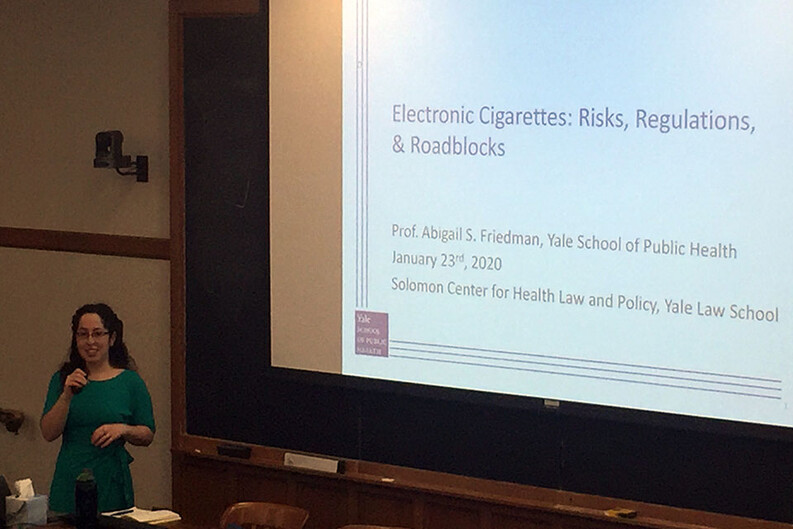Solomon Center Hosts Talk on E-Cigarettes and Vaping

On January 23, 2020, Professor Abigail Friedman of the Yale School of Public Health spoke at the Law School about the history and future of e-cigarettes. Her talk, hosted by the Solomon Center for Health Law and Policy and the Yale Health Law and Policy Society (YHeLPS), focused on the devices’ history, current and pending regulations, and particular challenges to regulation that future public policy must address. Specifically, Friedman laid out the difficulty in motivating change from smoking to vaping and the ways in which evidence can help effect policy.
Friedman explained that e-cigarettes are battery-powered devices that vaporize a substance, or transform it into aerosol, unlike traditional, combustible cigarettes. The first e-cigarettes entered the American market in 2006. They come in two major design categories: “cigalikes” have single-use cartridges (termed a “closed system”), while devices variously called “mods” or “e-pipes” have refillable tanks for vaping liquid (an “open system”). In 2012, the first established tobacco company entered the e-cigarette market; Juul entered the market three years later.
In 2009 the United States Court of Appeals for the District of Columbia Circuit found that the Food and Drug Administration (FDA) could not regulate e-cigarettes as drug delivery devices, but that the agency had the power to regulate them under the Tobacco Control Act as “tobacco products”. The FDA subsequently published a Deeming Rule, expanding the definition of “tobacco products” to include e-cigarettes. The FDA also established that e-cigarettes cannot be marketed without premarket tobacco product authorization. It permitted two temporary exceptions to this rule: products first marketed on or before February 15, 2007, and products on the market by August 8, 2016, which currently receive a delayed period of enforcement. The deadline for this temporary delayed enforcement, which has shifted repeatedly, stands at May 11, 2020. To date, no company has received premarket tobacco product authorization.
Recent federal regulations include two key provisions. First, the federal minimum legal sales age for e-cigarettes and other “tobacco products” was raised from 18 to 21. Friedman unpacked the evidence in favor of Tobacco 21 laws, which suggest a social multiplier effect in the desired age group that does, in fact, reduce smoking. Additionally, recent regulations include a ban on flavored cartridges, which the FDA says appeal to youth. Friedman noted, however, that the FDA ban of flavored cartridges does not apply to open systems, leaving smoke shops unimpacted. It also fails to address the type of e-cigarettes responsible for e-cigarette and vaping-product associated lung injury (EVALI) deaths in the past year. Friedman discussed proposed federal regulations, such as capping nicotine strength or banning flavored e-cigarettes outright. Since the FDA does not have the authority to levy taxes, it cannot tax e-cigarettes as some states have.
Attendees also learned of the equivocal evidence for health claims often used to justify e-cigarette use. The bulk of data upholds vaping as safer than smoking, but Friedman said that this was a low bar for comparison. Health concerns also differentially impact two groups, youth and adults, a recurring theme in public policy discussions. Vaping can aid adult smoking cessation, but no such data can be gathered on children, and while youth smoking has declined since e-cigarettes became available, children who vape are also more likely to smoke. Moreover, addictive substances can be particularly dangerous for developing brains, and the black market that exists for open systems is vulnerable to tampering.
In some ways, Friedman suggested, the clash between adults and youth smokers can distract from evidence-based policy. For instance, officials fret over candy-flavored products as a gateway to smoking, but adults also prefer novelty flavors and can use them to cease smoking. Making e-cigarettes less available to youth may incentivize black market purchases, which can be dangerous or even fatal, as seen in fatal lung injuries that resulted from lacing THC pods with vitamin E acetate. Simultaneously, solutions that make vaping more expensive — like higher percent-of-cost taxes applied by states — could motivate a shift from vaping to smoking.
Friedman pointed to two main policy levers. First, she said that regulators should consider relative taxes and the relative nicotine delivery of cigarettes and e-cigarettes to aid smoking cessation without promoting movement from vaping to smoking. Officials could also require that e-cigarettes be prescribed by pharmacists, so that regulating the general market could not harm smokers who are trying to quit. Second, Friedman said that regulators should reduce the black market’s viability through making these products less valuable to consumers and more expensive to sellers. Some solutions may include open-system buybacks, tamper-proof cartridges, or high-tech options like geofencing and “smart e-cigs.”
In conclusion, Friedman told the audience that the deadline for delayed enforcement falls within an election year. In listening to debates on this issue, she reminded attendees to beware of arguments that collapsing youth and adult behavioral groups and to separate data from dogma.


